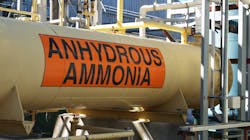Is Ammonia Ocean Transportation’s Route to Net-Zero?
Download this article in PDF format.
Nearly one-third of the world’s total consumed energy is used by the transportation sector, where fossil fuels like diesel, gasoline, jet fuel and other sources create high levels of greenhouse gases (GHGs).
“Although there is a big attempt to [convert] to electrical and hybrid vehicles by manufacturers and governments, it seems that it is not possible to complete this transition in a short time due to infrastructure, economical, and raw material issues,” Wiley reports. The use of ammonia in combustion processes (i.e., internal combustion engines and gas turbines) may be one solution to a faster transition over to the “hydrogen economy,” it adds.
Ammonia (NH3) is among the largest-volume chemicals produced and distributed in the world and is mainly known for its use as a fertilizer in the agricultural sector. In recent years, ammonia has sparked interest in the possibility of working as a high-quality energy carrier and as a carbon-free fuel in internal combustion engines (ICEs).
The International Energy Association (IEA) recently laid out a 2023 Net Zero Roadmap that suggests ammonia must emerge as the key shipping fuel if the industry is to reach net-zero emissions by 2050.
“While hydrogen and ammonia use in shipping is negligible at present, demand for these fuels is expected to rise greatly in the longer term in the projected scenario, with the increase in low-emissions hydrogen driven not just by shipping but also the other transport sectors,” Riviera News reports.
In its Net Zero Roadmap, the IEA describes how major engine makers are in the final stages of developing ammonia two-stroke engines for commercialization by 2025. Large methanol-powered container ships began entering the market for the first time this year, it adds, while small-scale hydrogen fuel-cell ferries also began operating in Norway and the U.S.
While there are currently no commercial ships operating on ammonia, the IEA says that about 150 ammonia-ready vessels were on order at the end of 2022 and present an opportunity to rapidly develop the associated safety protocols.
Hydrogen vs. Ammonia
Right now, liquid hydrogen (H2) and ammonia are two fuel sources that present promising carbon-neutral energy storage and transportation options, National Law Review reports.
“Which source will ultimately get the United States to its net zero goal — and emerge as a global clean energy storage commodity — depends on a variety of factors, including, potential uses as fuel, the availability of transportation infrastructure, safety considerations, and market conditions,” the publication adds, noting that ammonia “shows promise” as a replacement fuel for the maritime industry. Tests have shown that oceangoing vessels can be retrofitted to operate using ammonia as a fuel and, as such, significantly lower their carbon footprints.
Because ammonia is a key ingredient in fertilizer, its transport infrastructure is well established, with already-constructed terminals, pipelines, railcars and tankers designed for pressurized or refrigerated ammonia.
“Ultimately, it is not going to be an either/or play to get the nation to net zero emissions by 2050,” the publication concludes, “but rather, both hydrogen and ammonia will each have their roles at different stages of the energy transition movement.”
Making Waves
Last month, Mitsubishi announced the possible transition of the Namikata terminal (near Hiroshima, Japan) into a fuel ammonia import hub. According to Reuters, Japan views ammonia—which could be also produced as a derivative of hydrogen—as a key element in its net zero transition, and is pursuing this strategy together with coal in a test project which it hopes to expand nationwide.
Mitsubishi also signed a memorandum of understanding to study a potential clean ammonia production project in the U.S., located in Lake Charles, La. If successful that project could be built by the late 2020s and be a potential supply source for Japan, which according to Reuters wants to grow domestic ammonia consumption to 3 million metric tons annually by 2030.
Mitsubishi is studying the conversion of the Namikata terminal to receive ammonia from potential production projects in Lake Charles and Corpus Christi, Tex., both on the Gulf of Mexico coast.
Available, Affordable and Environmentally Friendly
In “Why Ammonia Is the Fuel of the Future for Maritime Shipping,” Maciek Lukawski says the fuel stands out as the most economically viable carbon-free fuel for this mode of transport. As the second most commonly produced chemical in the world, Ammonia also provides the benefits of hydrogen without the logistical and investment challenges.
From an energy standpoint, ammonia is broadly available, affordably priced, easy to store, and uses existing transport and storage infrastructure. “For maritime shipping to reach Net Zero 2050 goals, it’s imperative that the industry pivot away from carbon-emitting fuels and embrace alternative energy,” Lukawski writes. “Maritime leaders understand this, which is why they support a sensible ‘well-to-wake’ strategy for emissions reduction. Within such a framework, ammonia offers the best and clearest path forward to a decarbonized future.”
About the Author

Bridget McCrea
Contributing Writer | Supply Chain Connect
Bridget McCrea is a freelance writer who covers business and technology for various publications.






